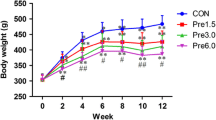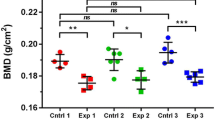Abstract
The effect of daily doses from birth of two diphosphonates, namely either ethane-1-hydroxy-1,1-diphosphonate (EHDP) or dichloromethylene diphosphonate (Cl2MDP), on the growth and the skeleton of mice has been studied. Diphosphonates slowed growth, the incisors did not erupt or erupted later, but the level of plasma calcium remained normal. The administration of Cl2MDP at a dose rate of 10 mg P/kg/day leads to skeletal changes that are similar to those observed in grey-lethal osteopetrotic mice, and the animals die after about four weeks of treatment. As compared with normal mice of similar age, treated mice had bones that were smaller, denser and more clubshaped, and the marrow cavities were filled with calcified bone or cartilage. The total amount of calcium in the carcass was not increased by diphosphonate treatment, as compared with the amount in normal mice of the same age. It is suggested that both in the grey-lethal and diphosphonate-treated mice many of the abnormalities are secondary to decreased bone resorption. The results are discussed with respect to the use of diphosphonates in pathological conditions of increased bone turnover and with respect to the role of bone resorption in the maintenance of plasma calcium levels.
Résumé
L'effet de doses quotidiennes, administrées depuis la naissance, de deux types de diphosphonates, à savoir l'éthane-1-hydroxyle-1,1-diphosphonate (EHDP) et le dichlorométhylène diphosphonate (Cl2MDP), sur la croissance et le squelette de souris a été étudié. Les diphosphonates freinent la croissance: les incisives ne font pas leur éruption ou elle est plus tardive. La calcémie est normale. L'administration de Cl2MDP à une dose quotidienne de 10 mg P/kg/jour provoque des modifications squelettiques identiques à celles des souris grises létales atteintes d'ostéopétrose et les animaux meurent après quatre semaines de traitement. Par rapport aux témoins, les souris traitées présentent des os plus étroits, plus denses et plus déformés: les cavités médullaires sont comblées avec de l'os calcifié et du cartilage. La quantité totale de calcium d'un animal n'est pas augmentée par traitement au diphosphonate, par rapport à un témoin de même âge. Chez les souris grises létales et celles traitées aux diphosphonates, la plupart des anomalies est secondaire à une résorption osseuse diminuée. Ces résultats sont commentés en fonction de l'emploi des diphosphonates au cours de remaniements osseux pathologiques augmentés et en fonction du rôle de la résorption osseuse dans le maintien de la calcémie.
Zusammenfassung
Mäuse erhielten von der Geburt an tägliche Dosen folgender zwei Diphosphonate: entweder Äthan-1-Hydroxy-1,1-Diphosphonat (EHDP) oder Dichloromethylen-Diphosphonat (Cl2MDP). Es wurde deren Wirkung auf das Wachstum und das Skelet untersucht. Die Diphosphonate verlangsamten das Wachstum, die Schneidezähne brachen nicht oder erst später durch, aber die Höhe des Plasmacalciums blieb normal. Die Verabreichung von Cl2MDP in Dosen von 10 mg P/kg/Tag führt zu Skeletveränderungen, welche denjenigen der „grey-lethal” osteopetrotischen Mäuse gleichen. Die Tiere sterben nach einer Behandlungsdauer von etwa 4 Wochen. Verglichen mit normalen Mäusen von ungefähr gleichem Alter hatten die behandelten Mäuse kleinere, dichtere und mehr keulenförmige Knochen, und die Markhöhlen waren gefüllt mit verkalktem Knochen oder Knorpel. Die Gesamtcalciummenge im Skelet wurde durch die Diphosphonatbehandlung nicht erhöht; dies ergab sich aus einem Vergleich mit der bei normalen Mäusen desselben Alters gefundenen Menge. Es wird vorgeschlagen, daß bei den „grey-lethal” und bei den Diphosphonat-behandelten Mäusen viele der Abnormalitäten als Folge der herabgesetzten Knochenresorption angesehen werden müssen. Die Ergebnisse werden einerseits im Hinblick auf den Gebrauch der Diphosphonate bei pathologischen Bedingungen eines erhöhten Knochenumbaus diskutiert; andererseits werden sie im Zusammenhang mit der Rolle der Knochenresorption bei der Erhaltung des Plasmacalcium-Spiegels besprochen.
Similar content being viewed by others
References
Bisaz, S., Russell, R. G. G., Fleisch, H.: Isolation of inorganic pyrophosphate from bovine and human teeth. Arch. oral Biol.13, 683–696 (1968).
Chen, P. S., Toribara, T. Y., Warner, H.: Microdetermination of phosphorus. Analyt. Chem.28, 1756–1758 (1956).
Fleisch, H., Bonjour, J. P., Morgan, D. B., Reynolds, J. J., Schenk, R., Smith, R., Russell, R. G. G.: Diphosphonates.In: Endocrinology 1971, p. 430–443. London: William Heinemann Medical Books 1972.
Fleisch, H., Russell, R. G. G., Bisaz, S., Casey, P. A., Mühlbauer, R. C.: The influence of pyrophosphate analogues (diphosphonates) on the precipitation and dissolution of calcium phosphatein vitro andin vivo. Calcif. Tiss. Res.2, Suppl. 10-10A (1968).
Fleisch, H., Russell, R. G. G., Francis, M. D.: Diphosphonates inhibit hydroxyapatite dissolutionin vitro and bone resorption in tissue culture andin vivo. Science165, 1262–1264 (1969).
Gasser, A. B., Morgan, D. B., Fleisch, H., Richelle, L. J.: The influence of two diphosphonates on calcium metabolism in the rat. Clin. Sci.43, 31–45 (1972).
Gaunt, W. A.: The development of enamel and dentine on the molars of the mouse, with an account of the enamel-free areas. Acta anat. (Basel)28, 111–134 (1956).
Grüneberg, H.: A new sub-lethal colour mutation in the house mouse. Proc. roy. Soc. B118, 321–342 (1935).
Grüneberg, H.: The relations of endogenous and exogenous factors in bone and tooth development. J. Anat. (Lond.)71, 236–244 (1937).
Grüneberg, H.: More about the tabby mouse and about the Lyon hypothesis. J. Embryol. exp. Morph.16, 560–590 (1966).
Hirsch, M. S.: Studies on the response of osteopetrotic bone explants to parathyroid explantsin vitro. Bull. Johns Hopk. Hosp.110, 257–264 (1962).
Jowsey, J., Holley, K. E., Linman, J. W.: The effect of sodium etidronate in adult cats. J. Lab. clin. Med.76, 126–133 (1970).
King, W. R., Francis, M. D., Michael, W. R.: Effect of disodium ethane-1-hydroxy-1,1-diphosphonate on bone formation in animals. Clin. Orthop.78, 251–270 (1972).
Mühlbauer, R. C., Russell, R. G. G., Williams, D. A., Fleisch, H.: The effects of diphosphonates on “immobilisation osteoporosis” in rats. Europ. J. clin. Invest.1, 336–344 (1971).
Murphy, H. M.: Calcium and phosphorus metabolism in the grey-lethal mouse. Genet. Res.11, 7–14 (1968).
Murphy, H. M.: A review of inherited osteopetrosis in the mouse. Clin. Orthop.65, 97–109 (1969).
Nordin, B. E. C., Peacock, M.: The role of the kidney in serum calcium homeostasis.In: Calcitonin 1969, p. 472–482. London: William Heinemann Medical Books 1970.
Reynolds, J. J.: A sensitivein vivo/in vitro method for studying substances that influence the resorption of bone.In: Calcium, parathyroid hormone and the calcitonins. Proceedings of an international symposium, p. 454–462. Amsterdam: Excerpta Medica Foundation 1972.
Reynolds, J. J., Dingle, J. T.: A sensitivein vitro method for studying the induction and inhibition of bone resorption. Calcif. Tiss. Res.4, 339–349 (1970).
Reynolds, J. J., Minkin, C.: Bone studiesin vitro: use of calcitonin as a specific inhibitor of bone resorption.In: Calcitonin 69 (Taylor, S., Foster, G. V., eds.), p. 168–174. London: William Heinemann Medical Books 1970.
Reynolds, J. J., Minkin, C., Morgan, D. B., Spycher, D., Fleisch, H.: The effect of two diphosphonates on the resorption of mouse calvariain vitro. Calcif. Tiss. Res.10, 302–313 (1972).
Reynolds, J. J., Morgan, D. B.: A combinedin vivo/in vitro study of the effects of diphosphonates on bone resorption. J. Bone Jt Surg. B52, 796–797 (1970).
Russell, R. G. G., Mühlbauer, R. C., Bisaz, S., Williams, D. A., Fleisch, H.: The influence of pyrophosphate, condensed phosphates, phosphonates and other phosphate compounds on the dissolution of hydroxyapatitein vitro and on bone resorption induced in tissue culture and in thyroparathyroidectomised rats. Calcif. Tiss. Res.6, 183–196 (1970).
Schenk, R., Merz, W. A., Mühlbauer, R. C., Russell, R. G. G., Fleisch, H.: Effect of ethane-1-hydroxy-1,1-diphosphonate (EHDP) and dichloromethylene diphosphonate (Cl2MDP) on the calcification and resorption of cartilage and bone in the tibial epiphysis and metaphysis of rats. Calcif. Tiss. Res.11, 196–214 (1973).
Smith, R., Bishop, M., Russell, R. G. G.: Diphosphonates and Paget's disease of bone. Lancet1971 I, 945–947.
Weiss, I. W., Fisher, L., Phang, J. M.: Diphosphonate therapy in a patient with myositis ossificans progressiva. Ann. intern. Med.74, 933–936 (1971).
Author information
Authors and Affiliations
Rights and permissions
About this article
Cite this article
Reynolds, J.J., Murphy, H., Mühlbauer, R.C. et al. Inhibition by diphosphonates of bone resorption in mice and comparison with grey-lethal osteopetrosis. Calc. Tis Res. 12, 59–71 (1973). https://doi.org/10.1007/BF02013722
Received:
Accepted:
Issue Date:
DOI: https://doi.org/10.1007/BF02013722




